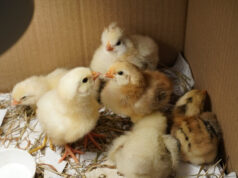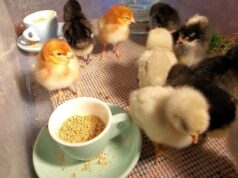Raising baby chicks can be a delightful experience, especially for poultry lovers. Ensuring that they have the right environment is crucial for their safety and growth. One essential component in this setup is the heat lamp in the brooder. In this piece, we’ll delve into some brooder heat lamp safety tips to help keep your chicks safe and healthy.

The Importance of Heat in a Brooder
When raising chicks, providing the right amount of heat is fundamental. Baby chicks are not able to regulate their body temperature on their own. This is why a heat lamp becomes necessary as it keeps the brooder warm, simulating the warmth they’d receive from a mother hen.
However, while heat lamps are beneficial, they can pose some risks if not used correctly. Therefore, understanding brooder heat lamp safety tips is essential for every chick enthusiast.
Choosing the Right Heat Lamp
With multiple options available in the market, it’s crucial to choose a heat lamp that aligns with your needs. Consider lamps that offer adjustable heat settings and focus on safety features. This ensures that your chicks remain warm without the risk of overheating or causing fires.
Types of Heat Lamps
- Ceramic Heat Emitters: These bulbs dont emit light and are known for their efficiency and longevity.
- Red Heat Lamps: These are common among chicken keepers and help reduce stress on chicks by providing a dim light.
- Safety-Certified Infrared Lamps: They not only provide the warmth chicks need but come with safety certifications, ensuring a reduced risk of accidents.
Regardless of your choice, always ensure the product you buy complies with safety standards.
Setting the Right Temperature
The temperature in your brooder is a crucial aspect. For the first week, aim to set the brooder at around 95 degrees Fahrenheit, reducing the temperature by 5 degrees every week. Monitor their behavior as they are the best indicators of their comfort. If they huddle together, it might be too cold, and if they stay far from the heat source, it might be too warm.
Using Thermometers
A digital thermometer can be incredibly helpful. Place it at chick-level to get an accurate reading of their ambient temperature. Regular checks will aid in maintaining the correct setting, ensuring happy and healthy chicks.
Positioning Your Heat Lamp Safely
Proximity matters! A heat lamp that’s too close can overheat the brooder, posing fire risks. Conversely, one that’s too far won’t provide sufficient warmth. Adjust the height based on the behavior of your chicks and their comfort levels.
Distance Between the Lamp and the Brooder
To find the sweet spot, start by placing your lamp around 18-24 inches above the brooder. Gauge the chicks’ reactions and adjust accordingly. Always ensure the lamp is firmly secured and cannot be knocked over easily.
Regular Maintenance and Checks
Heat lamps, like any equipment, require regular checks. This not only prolongs their lifespan but also ensures uninterrupted warmth for your chicks.
Inspecting Bulbs and Fixtures
Regularly check for signs of wear or damage. A faulty bulb can lead to temperature inconsistencies. Also, dust or dirt on lamps can be a fire hazard.
Avoiding Common Heat Lamp Mistakes
Many novice chicken enthusiasts make avoidable mistakes, which can be detrimental.
Using Multiple Heat Sources
While redundancy might seem wise, using too many lamps can cause overheating. If you wish to use more than one lamp, ensure they’re evenly spaced and never directly pointed at the same spot.
Protecting the Chicks
Remember, baby chicks are curious! Ensure the lamp’s cord is out of their reach, preventing pecking or tangling.
Using a Reflective Shield
This can help focus the heat downwards, ensuring even distribution and reducing wastage.
Safety First: Using Alternative Heating
If heat lamps make you nervous, consider alternatives like heated pads or plates. These are efficient and remove the risk of fires.
Brooder Heating Plates
These mimic a hen’s warmth and allow chicks to move closer or further away based on their comfort.
For more detailed information, check out the insights from this helpful guide on chick care.
Choosing the Best Brooder for Safety
Setting up a brooder involves more than just the heat source. A well-designed brooder ensures the safety and health of your chicks.
Size and Space Considerations
Your brooder’s size should accommodate the growth of your chicks. Having ample space ensures they aren’t crowded, reducing stress and promoting healthy development.
Material Selection
Choose non-flammable materials. While wood is a common choice, ensure it’s adequately treated against fires.
Want to know more about setting up your brooder in the right way? Here’s an insightful resource from Chicken Things and More.

Frequently Asked Questions
How often should I check my heat lamp?
Regular checks, preferably daily, ensure your equipment is in top condition and there’s no risk of accidents.
Can I use a regular household lamp for my brooder?
No. Regular lamps aren’t designed to provide the necessary heat levels and could pose a danger.
What’s the best way to ensure my chicks are comfortable?
Observe their behavior. Happy chicks are usually evenly spread, not too close or too far from the heat source.
This article contains affiliate links. We may earn a commission at no extra cost to you.











